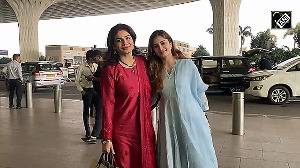Now that the fuss over Diwali is behind us, and the time for quieter celebration has set in, you might consider popping a bottle of chilled bubbly and placing it in a tub of ice.
It's what civilised people all over the world are doing. And in globalised India, celebrating (the Sensex, FIIs, the neighbour's son's wedding, your promotion) has come to mean uncorking a bottle of the finest to get tipsy on those glorious bubbles.
At least, that's what Charles Henri Gonet is counting on.
The proprietaire of Michel Gonet et Fils is hoping the Indian economy will find increasing reasons to cheer with champagne. No wonder he's prospecting in the Indian market with four champagnes (and 12 wines), the latest to lay his footprint in the fine wines segment.
For decades now, Indians have celebrated with indifferent champagne, usually poorly stored, vinegarish to the taste, and highly acidic in its content.
But in recent years, the trend has moved towards asking for champagne by the label, and is altogether a more elegant affair, just the right amount in slim tulips, sipped before it warms in our tropical climate.
Gonet, however, will find his task cut out for him. Check around in the market, and most people will demand the "best". Which is? Depending on your exposure and associations with champagne drinking, this could range from Bollinger (the absolute favourite) to Moet Chandon and Dom Perignon.
At another level altogether is the home-grown (and therefore not legally champagne but rather champagne-like or sparkling wine) Marquise de Pompadour.
Ashwin Deo, MD, Moet Hennessy India, who has probably the largest bouquet of champagnes on offer (Moet Chandon, Rs 3,000; Dom Perignon, Rs 8,500; Krug, Rs 9,350; Veuve Clicquot, Rs 3,630, La Grande Dame, Rs 8,500; and Ponsardin), says: "Awareness for champagne has increased dramatically over the last five years.
"It's become a natural corollary to the increase in wine consumption. A 25-30 per cent increase in wine (including champagne) is being witnessed year-on-year in India."
That's still a small, niche market with a total consumption of 1,20,000 bottles of international wines and champagnes. "But it will grow further as duties are rationalised," he promises. Which should be reason enough to celebrate.
Of course, these aren't the only champagnes in the market, and hotels can trot out impressive lists that now also include Louis Roederer Brut, Pommery Brut, Laurent Perrier and Grand-Taupe, among others.
At ITC Maurya Sheraton, where bottles are ordered from Rs 4,000 to Rs 15,000 (for the Krug Grand Cuvée), F&B manager Tejinder Singh comments, "It says a great deal about the person drinking it.
The whole ceremony of serving champagne is grand. The opening of the cork is always done with a lot of panache." Usually noticeable all over the restaurant so that you feel like a heel unless you follow up with one of your own, but let that pass for now.
"Usually though," he adds, "those in the Rs 4,000-5,500 range sell well, and it's only those with more discerning tastes who opt for vintage and higher priced brands."
At 360o at The Oberoi, bartender Jimmy Joseph says he's doing quite well with the champagne-by-the-glass (Rs 1,200 per), thank you. "Champagne is a good, light drink that is soothing, glamorous and elegant," he figures. No wonder his guests are willing to pay from Rs 2,000 to Rs 9,000 a pop.
"Pink champagne," he informs us, "is glamorous and its trend has set in beautifully." So have cocktails (at Rs 650-950 each), and among the most popular are Sparkling Blue (champagne + blue curacao), Nimosas (champagne + fruit juice) and Bellini (champagne + peach schnapps + peach pulp + fruits).
At The Imperial, communications head Aruna Dhir says champagne bottles can be heard popping all over its restaurants as guests ask for it as an aperitif, or celebrate birthdays, anniversaries, contracts... "The Indian consumer," she says, "relates to it like they would to any other luxury product."
Popular champagnes sold here include Moët & Chandon, Brut Imperial, Pol Roger "Extra Cuvée de Réserve", "S" Salon "Blanc de Blancs" 1988, Taittinger "Comtes de Champagne" 1995, Dom Pérignon Vintage 1996, and Krug Grande Cuvée among the premiums, and Moët & Chandon Brut Impérial and Veuve Clicquot Brut Yellow Label among the more popular.
Increasingly, guests can be seen comparing notes about the vanilla, praline, fruitiness, mellow richness or mossy softness of their champagnes. A sign that the Indian champagne drinker has matured? Michel Gonet is hoping so.
But in any case, if you wish to get a little more from your bubbly, The Imperial would have you follow these simple tips:
Please the eyes. Make sure the champagne has sparkle, colour (greenish-yellow for Chardonnay, golden-yellow for Pinot-Noir, dark amber if it's aged well) and limpidity. The last is important - a cloudy champagne means you aren't getting your due.
Please the nose: the most powerful, though delicate, aromas will be natural (citrussy for Chardonnay, red fruit and berries for Pinot-Noir, or white-flesh fruits for Pinot-Meunier). But around these you'll get to enjoy some secondary aromas (perhaps a bakery?) and perhaps tertiary ones too.
And finally, please the palate: Here, each distinct note will be spelt out, whether fruity or spicy, and it is this, above all, that will make or mar your experience of enjoying a superlative champagne.






 © 2025
© 2025